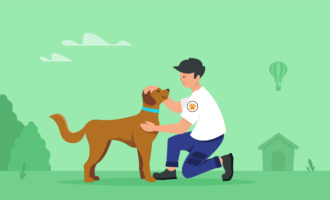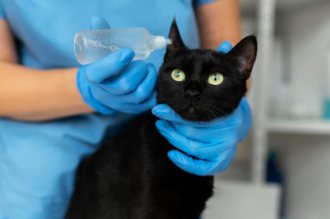Becoming a no-kill shelter not only helps save adoptable, healthy animals, but it can also improve how the general public views your shelter and bring in more prospective adopters.
A no-kill shelter tries to save every animal that comes through its doors: It treats the sick and injured ones, rehabilitates those with behavioral issues, and works with the community to educate them about spaying and neutering their pets. The only time an animal is euthanized is as an act of mercy, not as a convenience or for lack of space.
To transform your shelter into a no-kill shelter, you’ll need to do more than just change the mission statement and build more habitats for animals. There’s an entire culture shift that may need to happen, and you’ll need to lean on the community for support. Here’s what you need to do.
How to become a no-kill shelter
- Make the financial case for the transition
- Examine existing policies and procedures
- Build community partnerships
- Create a spay and neuter program
- Begin a pet fostering program
- Consider other new programs to keep animals out of shelters
- Make sure the shelter is inviting
Make the financial case for the transition
Examine existing policies and procedures
Build community partnerships
Create a spay and neuter program
Begin a pet fostering program
Consider other new programs to keep animals out of shelters
Make sure the shelter is inviting
Like most nonprofits, you might run up against financial objections to becoming a no-kill shelter. There may be concerns about how you’ll be able to house more animals and conduct programs to support your mission, like spay and neuter programs and educational initiatives.
It can actually cost more to euthanize animals than to adopt them out to homes. No-kill shelters are cost-effective and can improve the local economy through tax revenues and the purchase of pet supplies from adopters.
No-kill shelters also bring in more community support in the form of donations and volunteers. These types of shelters appeal to potential adopters, and animal shelters across the country have found that, after converting to a no-kill philosophy, they’ve increased their overall revenue.
After you get buy-in from everyone involved, examine how you operate now and where you can change policies and procedures to better reflect your new mission. You may want to rewrite job descriptions to better emphasize how you’re saving lives, like changing “kennel attendants” to “animal caregivers.”
You may need to change the language on your website to make it less intimidating for people to adopt. Also, look at your volunteer policies. For example, one shelter didn’t allow volunteers in cat rooms without permission slips, but now volunteers are encouraged to go in and interact with the animals.
Take a look at your customer service and revamp it, if need be, to encourage more people to adopt. That can include being open for extended hours and opening on some holidays to make the shelter more accessible for working families. Some shelters have also lowered their adoption fees, which encourages people to take home a new friend.
Other organizations can help you achieve your no-kill shelter’s mission. If you don’t already, see if you can partner with local rescue groups, including breed-specific groups. Consider partnering with cat cafes and organizations that train service dogs. Some of the dogs that make it into your shelter might be ideal service animals or could be trained to be comfort or emotional support animals.
As a bonus to everyone involved with the partnerships, you can pool resources to provide professional development opportunities for shelter staff and animal control personnel, as well as host programs for the community.
In addition to spaying and neutering animals that come through your shelter’s doors, use community and corporate sponsorships to provide low-cost spay and neuter services. This will reduce the number of animals that need to stay at your shelter. Similarly, targeted community cat programs that trap, neuter, and return stray cats can keep these feral animals out of shelters and reduce the number of homeless cats on the streets.
To make sure your no-kill shelter has space for as many animals as possible, implement a program for members of the public to provide foster homes for adoptable pets. Reach out to existing volunteers, and make sure you include fostering opportunities on your website.
Owning a pet may not be realistic for a lot of people, but keeping one in their home for a limited period of time may be. Senior citizens, people who work from home, and even college students may make good foster parents for some of these animals.
If you do start a fostering program, make sure you keep accurate records of where each animal is. If possible, develop an online orientation program for foster homes that includes your mission and vision, guidelines for fostering, requirements, procedures, and how to care for the animal. This will make it easier to onboard new foster homes.
There are a lot of other things you can do to help keep pets in their homes or rehome animals. For example, you could start a help desk program staffed by volunteers to help people with animal behavior issues, and answer questions either over the phone or via email. If you’re located in a rural or semirural area, you can also start a barn cat program to place feral cats.
Finally, the best way to become a no-kill shelter is to make the shelter welcoming for prospective adopters from the moment they set foot in the entrance. You may need to redesign some things in your shelter to do this.
Keeping your shelter clean (i.e., promptly addressing animal waste) can go a long way toward getting people to hang around. Set up play areas where people can interact with the animals. Once the humans are in the door, it’s up to the animals to do the rest, and when animals can play with potential new friends, the interaction will be what tips the scales.
Even if the animals aren’t adopted right away, the socialization is good for them. It decreases stress for the animals and helps prevent behavior issues caused by isolation.
When you become a no-kill shelter, not only do animals benefit, but humans and the community do too. Make the financial case, start changing policies and procedures, build community partnerships, and start new programs to help keep animals alive and find their furever homes.











Send Comment:
1 Comments:
More than a year ago
Thank you. Starting the process.